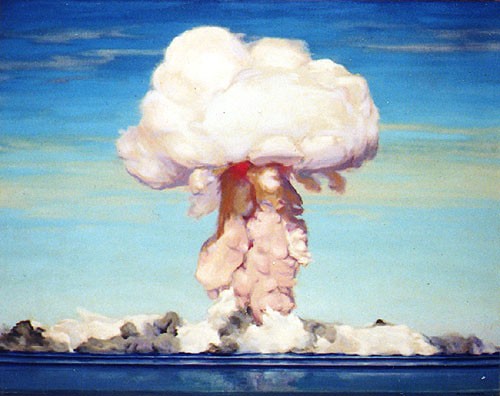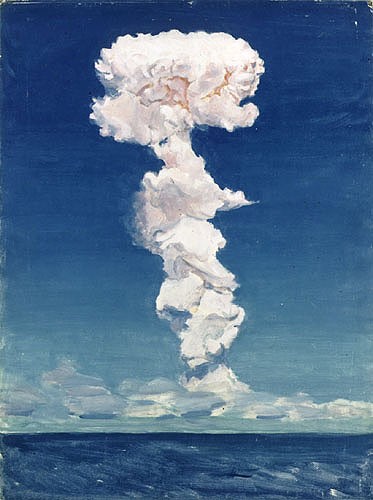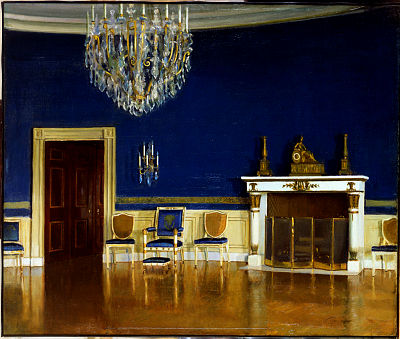![Charles Bittinger (1879-1970), Smithsonian Institution Archives, SIA Acc. 90-105 [SIA2007-0244]. Charles Bittinger (1879-1970), Smithsonian Institution Archives, SIA Acc. 90-105 [SIA2007-0244].](https://ids.si.edu/ids/iiif/SIA-SIA2007-0244/full/300,/0/default.jpg)
Born in Washington, D.C., on June 27, 1879, Charles had enrolled at MIT in 1898, intent on studying science, but dropped out two years later to study art in Paris. It was a glorious time to be young and to be an artist in the Latin Quarter, to summer in Italy, to fall in love. In 1904, Charles married Radcliffe College graduate and music student Edith Gay (1874-1970). For a while, the newlyweds continued their Bohemian life in France. With talent and inherited means, Charles was establishing a reputation in the art world, as his detailed, glittering interiors (such as “The Blue Room,” 1903, which is in the White House Collection, and “Bibliotheque du Dauphin, Versailles,” 1906) won critical acclaim.
In 1907, the couple returned to the United States, living in New York City and summering in Massachusetts. The artist’s landscapes and portraits continued to win prizes and positive notices, but Charles remained fascinated with science. During World War I, he found a way to merge his interests and talents. As a member of the U.S. Navy’s Camouflage Section, he developed innovative approaches to using visual dissimulation to shroud and screen ships. Along with scientists at the U.S. Bureau of Standards, he experimented with colored filters and colored lights. He also patented several inventions during the 1920s and 1930s, such as urban rail lines designed to mitigate damage to vehicle tires and a rear-view mirror with two reflection factors.
The Bittingers moved to Washington in 1929, and around that time, Charles began working with the astronomy community to paint natural phenomena that could be only fleetingly recorded on film. One of his “portraits of the sun’s spectrums” was exhibited in November 1928 at the meeting of the Optical Society of America. His 1931 “portrait” of the element Rhenium depicted each of the thousands of different spectrum lines in a different hue.

In Washington, Charles and Edith lived in the Georgetown neighborhood, near Dunbarton Oaks, and Charles maintained a studio close by. They became beloved members of the local social communities that included science and art, participating in such elite organizations as the Cosmos Club and Arts Club (which Charles served as president in 1933). The couple raised money for the symphony and the arts, and, with her Garden Club friends, Edith helped to fund and create the beautiful Fern Valley at the U.S. National Arboretum.
At some point, Charles met Watson Davis, perhaps at the Cosmos Club, and began a cordial relationship, for Science Service covered many of the artist’s technical projects. In 1931, Bittinger was a charter member of the Inter-Society Color Council and two years later, he spearheaded establishment of “The Colorists,” whose membership included artists and scientists interested in the “artistic, commercial, and scientific aspects of color.”
In 1934, Charles undertook an ambitious commission from the Franklin Institute in Philadelphia: three “invisible” murals depicting the life of Benjamin Franklin. Using fluorescent colors invisible to the human eye under normal circumstances, Charles created paintings that revealed the Franklin images when illuminated by ultraviolet light.
During World War II, Charles continued his camouflage work as an officer in the U.S. Navy, but none of his past experiences (painting in Versailles and the White House, reconceptualizing the use of color) could have prepared him for what he saw in July 1946. As one of three artists onboard the U.S.S. Appalachian, he had a front row seat when nuclear weapons were tested at Bikini Atoll in the Marshall Islands. Bittinger’s oil paintings preserve an awesome sight, as the fireballs rose and then cooling vapors created enormous clouds. When the clouds roiled and blossomed over the ocean, and towered over the ships, the potential of their power placed humanity into perspective.
Bittinger died in December 1970, eight months after the death of his wife Edith. He left behind a bright legacy on canvas, and a model of a fascinating career bridging the worlds of art and science.
Related Resources
Record Unit 7433, Ruel P. Tolman Collection, 1909-1964, Smithsonian Institution Archives
Record Unit 7091, Science Service, Records, circa 1910-1963, Smithsonian Institution Archives
Operation Crossroads, Marshall Islands, 1946, Smithsonian Institution Archives
Mom, can we keep him? Ummm, no, The Bigger Picture, Smithsonian Institution Archives
Produced by the Smithsonian Institution Archives. For copyright questions, please see the Terms of Use.





Leave a Comment